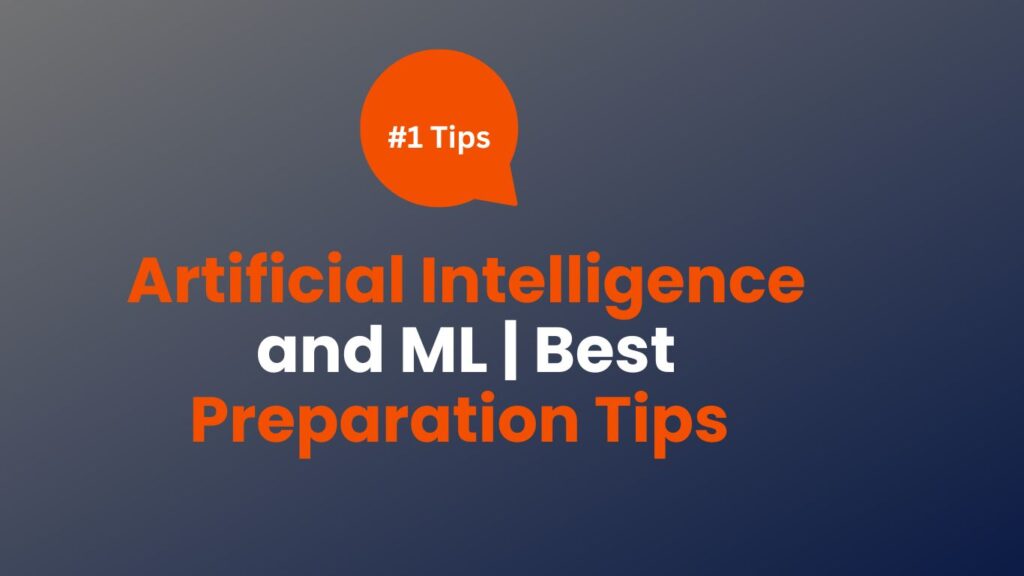What Is Artificial Intelligence?
With the goal of creating intelligent systems that automatically learn from data, ai artificial intelligence and machine learning (ML), two fields that are rapidly expanding, are both active today. An incremental approach is necessary when developing an AI system, starting with defining the issue and gathering pertinent data.
The subsequent steps include choosing the most appropriate algorithms, creating and training models using ML techniques, testing and evaluating the outcomes, and finally deploying the system for use in real-world applications.
The first step in learning how to prepare machine learning and ai artificial intelligence is to comprehend that there are various types of AI, including weak or narrow AI.

Table of Contents
Engineering Computer Science Best Guide
Best 10 Ways To Preparation for Artificial Intelligence
Machine learning: With machine learning, algorithms are trained to learn from data rather than being explicitly programmed. Natural language processing, speech recognition, predictive analytics, and other similar tasks frequently use this methodology.
Deep learning: Deep learning is a branch of machine learning that employs neural networks with numerous layers to tackle challenging issues. Common applications of this method include speech and image recognition, natural language processing, and autonomous driving.
Natural language processing: Teaching computers to comprehend and produce human language is the goal of the AI subfield known as natural language processing (NLP). This method is frequently applied to projects like sentiment analysis, language translation, and chatbots.
Computer vision: A branch of AI called computer vision teaches machines to comprehend and analyze visual information from their environment. For tasks like object recognition, facial recognition, and autonomous driving, this method is frequently employed.
Robotics: Designing and constructing physical robots that can complete tasks on their own or under the direction of humans is called robotics. Combining AI methods like computer vision and machine learning is a common practice in robotics.
Expert systems: Expert systems are artificial intelligence (AI) programs that simulate a human expert’s decision-making processes in a specific field. The use of these systems is widespread in fields like engineering, healthcare, and finance where complex decision-making is required.
Reinforcement learning: A branch of machine learning called reinforcement learning teaches agents to base their decisions on rewards or penalties. This method is frequently applied in robotics, gaming, and other applications where an agent must learn to make decisions in a changing environment.
Read More: Best Engineering Admission process
The Future of AI: Opportunities and Challenges Ahead
Artificial intelligence (AI) is poised to transform how we work and live, opening up a plethora of opportunities for companies that use it wisely. But this ai technology is not without its difficulties and dangers. As AI becomes more common, one issue is the potential for job displacement.
Making sure AI is created and used ethically, responsibly, and without any unintended consequences is another challenge. Businesses implementing AI technology must be aware of these difficulties and take steps to minimize them while maximizing the potential advantages. With careful planning, your company can be ready for the future of AI, take advantage of the limitless opportunities it presents, and meet the challenges that lie ahead.
Employee training on how to use these systems can also increase productivity and lessen resistance to change. Businesses should carefully consider the opportunities and challenges before beginning their AI journey, just like they would with any significant ai technology adoption.
The Impact of AI on Business and Society
AI has a significant and broad impact. Almost every sector, including healthcare, finance, and transportation, could be completely transformed by it. Processes that were once time-consuming and expensive can be automated by AI, increasing business efficiency and lowering costs. Moreover, AI can assist in finding patterns in data that humans might not have been able to recognize, facilitating better decision-making and problem-solving.
Thoughts on the morality of using AI in decision-making processes as well as worries about job displacement brought on by automation are also present. It’s critical for both individuals and businesses to stay informed about the implications of AI and how it will change our world as society moves toward a more technologically dependent future.
Ensuring Ethical and Responsible Use of AI
It is crucial to ensure that artificial intelligence (AI) is used ethically and responsibly as its use spreads. Without considering the potential effects on individuals or society as a whole, AI technology implementation may have unintended consequences. It’s critical to consider your business decisions from an ethical perspective, especially in light of algorithmic bias and data privacy, to prevent this. Transparency in AI decision-making processes can also foster stakeholder trust and avoid the perception of opaque decision-making.
In order to reduce risks and make sure that you are adhering to any legal obligations, it is important to stay current with regulatory requirements pertaining to AI. Businesses can better position themselves for long-term success while promoting beneficial societal outcomes by ensuring ethical and responsible use of AI.
Read More: Top Preparation Tip and Tricks for Artificial Intelligence and Machine Learning
Developing a Strategy for AI Implementation
A strategy for efficient implementation must be developed as the influence of artificial intelligence (AI) on various business aspects continues to increase. Prior to scaling up your experiments, start with small-scale ones by identifying the specific processes or areas of your business where AI can be most useful. To assist in integrating AI technology into current systems and workflows, think about hiring or providing training for experts in the field.
Additionally, it’s critical to think about any potential ethical repercussions and the effect on your workforce. Rather than being replaced by AI systems, make sure that employees are adequately trained and reskilled to work alongside them. Finally, to keep up with changing ai technology and stay ahead of the curve, periodically review and evaluate the success of your AI strategy.
Prompt Engineering Course In India
What Is Machine Learning?
The practice of teaching machines to learn from data without explicit programming is known as machine learning (ML), which is a subset of artificial intelligence (AI). Machine learning seeks to mimic how humans learn through experience by giving computers the ability to learn from data and make decisions.
Machine learning involves training algorithms on a sizable dataset in order to discover patterns and connections in the data. Following that, the algorithm bases its decisions or predictions on new data on these patterns.
The 3 primary categories of machine learning are:
Supervised learning: In supervised learning, the algorithm is trained on data that has been given a label, meaning that each piece of input data has an associated value. The algorithm must learn the correlation between the input and output variables in order to be able to predict new data with accuracy.
Unsupervised learning: With unsupervised learning, there is no corresponding output value because the algorithm is trained on unlabeled data. The algorithm’s objective is to find relationships and patterns in the data, like grouping together pieces of information that are similar or spotting anomalies.
Reinforcement learning: In reinforcement learning, the algorithm picks up new skills through error and feedback in the form of rewards or punishments.
How to Preparation For Machine Learning?
A combination of technical abilities and knowledge from disciplines like programming, mathematics, and statistics are required to prepare for Machine Learning (ML). You can follow the steps listed below to get ready for ML.
Learn programming languages: Programming languages like Python, R, and Java are used to implement machine learning. At the very least, you ought to be proficient in one of these languages.
Develop your mathematical skills: Numerous mathematical concepts, such as probability theory, calculus, and linear algebra, are used in machine learning. To be able to create and comprehend machine learning (ML) algorithms, it’s critical to have a solid grasp of these ideas.
Learn data analysis skills: Large datasets must be worked with when using machine learning, so proficiency in data analysis, data visualization, and data cleaning is essential.
Understand ML algorithms: Supervised learning, unsupervised learning, and reinforcement learning are a few of the different kinds of ML algorithms. It’s critical to comprehend how these algorithms operate and when to apply them.
Learn ML frameworks and libraries: There are numerous machine learning frameworks and libraries available, including TensorFlow, PyTorch, and scikit-learn. The creation of ML models can be made simpler with the aid of these tools.
Get hands-on experience: The development of ML abilities requires practice. To gain real-world experience, you can take online classes, compete in Kaggle challenges, or create your own ML projects.
Stay up-to-date with the latest developments: It’s critical to keep up with the most recent research, trends, and tools because machine learning is a field that is rapidly evolving. To stay informed, you can read research papers, go to conferences, or follow ML experts on social media.
Develop soft skills: Soft skills like communication, problem-solving, and critical thinking are equally as crucial in ML as technical skills are. Working in teams, explaining complex ideas to non-technical stakeholders, and coming up with original solutions to problems are frequently requirements for ML projects.
Consider advanced education: In-depth knowledge and hands-on experience in ML development can be obtained by pursuing a master’s or PhD in machine learning, data science, or computer science.
Gather and Understand Your Data
Getting your data together and understanding it is one of the most important steps in getting ready for any machine learning project. Finding excellent data sets that are pertinent to the opportunity or problem you are trying to solve is required. Before incorporating this data into your machine learning models, you must make sure it is clear, accurate, and comprehensive.
Take the time to carefully examine and comprehend the data you are using; doing so will enable you to spot important trends, patterns, and insights that can help you make smarter business decisions. Keep in mind that the caliber of your input data has a significant impact on the caliber of your output. Consequently, invest in reliable data preparation processes up front to ensure that you are building on a solid foundation.
Define Your Problem and Decide on Objectives
It’s critical to have a firm grasp on the issue you’re attempting to solve and the goals you want to accomplish before beginning any machine learning project. This will help direct your strategy and guarantee that you stay on task throughout the project. Spend some time outlining the specific problems that need to be solved and how machine learning can be used to solve them.
Next, decide what success means for your project and what your goals are. This will provide you with a strong base upon which to build and allow you to track your progress as you go. You’ll position yourself for long-term success by outlining your problem and goals in advance.
Explore Preprocessing Techniques to Improve Data Quality
Preprocessing is the cleaning and transformation of raw data into a format appropriate for machine learning algorithms. A model’s performance may be adversely affected by data of poor quality, such as those with duplicate values or missing entries, which can lead to biased or unreliable results. Thus, it is essential to use preprocessing methods to raise the caliber of your training data.
These methods might include dealing with missing values, encoding categorical variables, scaling or normalizing features, and handling outliers. Better performance and precise predictions from your machine learning models are guaranteed by careful planning and high-quality data.
Plan and Configure Model Training and Selection Techniques
Planning and setting up the model training and selection techniques comes after your data has been processed in order to get ready for machine learning. To do this, you must train the model with your prepared data using an appropriate algorithm or set of algorithms. Grid search, cross-validation, and automated machine learning tools are just a few of the techniques available for choosing the best algorithm.
The objective is to select the approach that offers the best performance metrics for the problem you’ve chosen. In order to further enhance performance, it is also critical to optimize hyperparameters at this stage. You will improve the quality of your models and ensure better results from your machine learning projects by planning and configuring the model training and selection techniques.
Engineering Computer Science Projects for Final Year
Frequently Asked Question
Q: What is the difference between Artificial Intelligence and Machine Learning?
Ans: Artificial Intelligence (AI) is a broader concept that involves creating machines that can perform tasks that normally require human intelligence. Training machines to learn from data without being explicitly programmed is known as machine learning (ML), which is a subset of artificial intelligence.
Q. What are some common applications of AI and ML?
Ans: Speech recognition, image recognition, natural language processing, recommendation systems, fraud detection, and autonomous vehicles are just a few of the fields and uses for AI and ML.
Q: What are some programming languages commonly used in Artificial Intelligence and ML?
Ans: Python, R, and Java are commonly used in Artificial Intelligence and ML development.
Q: What are some ethical concerns related to Artificial Intelligence and ML?
Ans: Algorithm bias, job displacement, privacy issues, and the potential for AI to be used maliciously are some ethical issues with AI and ML.
Q: What are some challenges in developing Artificial Intelligence and ML?
Ans: Acquiring and managing large amounts of data, choosing appropriate algorithms, addressing ethical issues, and ensuring the security and dependability of AI systems are some challenges in the development of AI and ML.
Q: How can I learn more about Artificial Intelligence and ML?
Ans: There are many resources available to learn about AI and ML, such as online courses, books, blogs, and forums. It’s important to have a strong foundation in programming, mathematics, and statistics to be able to develop AI and ML systems.
Q: What are the three types of prompting?
Ans: Basically, there are three types of prompting:
1.Verbal prompting.
2.Visual Prompting.
3.Physical Prompting.



